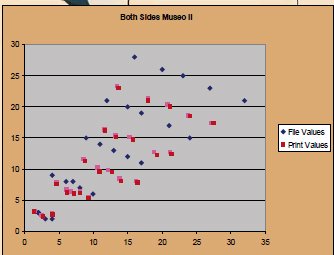articles/Paper/museofineartpaper-page3
Museo Fine Art Paper - Paper Chase - part 3 of 1 2 3 4 5 6
Published 01/10/2008

This media is available in two weights, 250gsm and 365gsm. The literature claims that it has the highest gamut of any fine art material available, a claim we could not substantiate as the definition of such a material is too vague!
Using the website profile, the print quality was only moderate. Although the saturation was high, it was at the expense of the shadow areas which were blocked up to an indeterminate level off the scale of our test target (ie at more than 40 RGB points). We used the instructions on the Museo website, namely turning Black Point Compensation (BPC) 'off', perceptual rendering intent, Enhanced Matt paper as the media setting and 1440dpi resolution. We showed the effect of not using BPC in the April-May issue (page 124) but, in a nutshell, using BPC opens the shadows and loses saturation. However, for the monochrome worker shadow detail is usually important. Looking at the audit print, there was a visual jump in the greyscale gradient, a density reversal in the Granger Chart and an apparently very bright, saturated print. The highlights were quite well rendered up to 250 RGB points.
The statistics confirmed the visual impression. The print was over-saturated in the skin tones, an unusual result. The grey linearity curve ran down to 20% luminance value before flattening out fully. The Dmax was 1.48 and the metamerism 1.4. The errors were highest in the blues and magenta reaching a value of 20 Lab points. Despite this the average error was a reasonable 3.26ΔE 2000 across the Macbeth swatch set.
Using our own profile and with BPC turned on produced a cleaner set of tests. The Granger Chart was more open, the discontinuity in the greens was absent and the saturation was reduced to more usual levels. Overall the print was not as heavy on density and there was less evidence of gloss differential and patchiness. The highlights extended to 250 RGB points. The average error was reduced to 6.2 Lab ΔE/2.75 ΔE2000, good values for a matt product. No change was made to the Dmax but the curve was straightened up so that the shadows were open down to 25 RGB points.

This is an extra-smooth surface intended for the reproduction of photographic images. It is 300gsm in weight.
As with other media we had a web profile and we generated one for ourselves. The effect was the same, presumably due to our using BPC. The web profile resulted in a higher saturation image with higher errors overall although the differences in the statistics were quite small. The bespoke profile once again removed the tone reversal in the Granger Chart. However, we found an additional problem when printing some real images. Use of Relative Colorimetric rendering intent posterised some of the skin tones. This was worse with the bespoke profile than with Museo's own profile from the web. The exercise illustrated the need to make real prints.
The statistics gave no warning of the posterisation even though it did show both in the paper print and when we soft-proofed in Photoshop using the icc profiles for the paper. The 'flaw' such as it was, was partly down to the image which was soft focus at too low a bit depth - all the profile did was exaggerate the situation due to a further compression of the tone range. The effect was not present though with the Hahnemuhle Photo Rag Ultra Smooth paper.
Museo II
Please Note:
There is more than one page for this Article.
You are currently on page 3
- Museo Fine Art Paper - Paper Chase page 1
- Museo Fine Art Paper - Paper Chase page 2
- Museo Fine Art Paper - Paper Chase page 3
- Museo Fine Art Paper - Paper Chase page 4
- Museo Fine Art Paper - Paper Chase page 5
- Museo Fine Art Paper - Paper Chase page 6
1st Published 01/10/2008
last update 09/12/2022 14:56:53
More Paper Articles
There are 30 days to get ready for The Society of Photographers Convention and Trade Show at The Novotel London West, Hammersmith ...
which starts on Wednesday 14th January 2026





